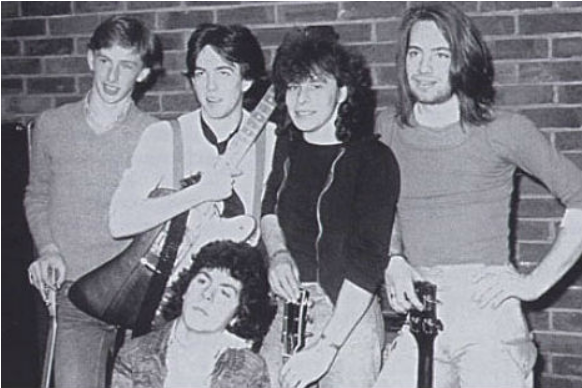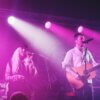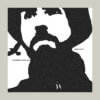Crawley’s most internationally acclaimed sons, The Cure, celebrated their 40th Anniversary in 2018 with their 65,000-capacity Hyde Park gig, either side of the shows, Crawley Museum put on The Cure Exhibition. Fans came from across the globe, some with suitcases, ready to fly back home from Crawley to Japan, Mexico, Australia, Germany, Poland and all over the world after making their pilgrimage to the Cure’s home town. In November 2022, Crawley Museum was kind enough to open up the 2018 archive images to GIITV, where we were treated to memories and archive treasures from the band’s youth, including postcards from Crawley sent by Robert Smith, shared by archivist, Darren Guy.
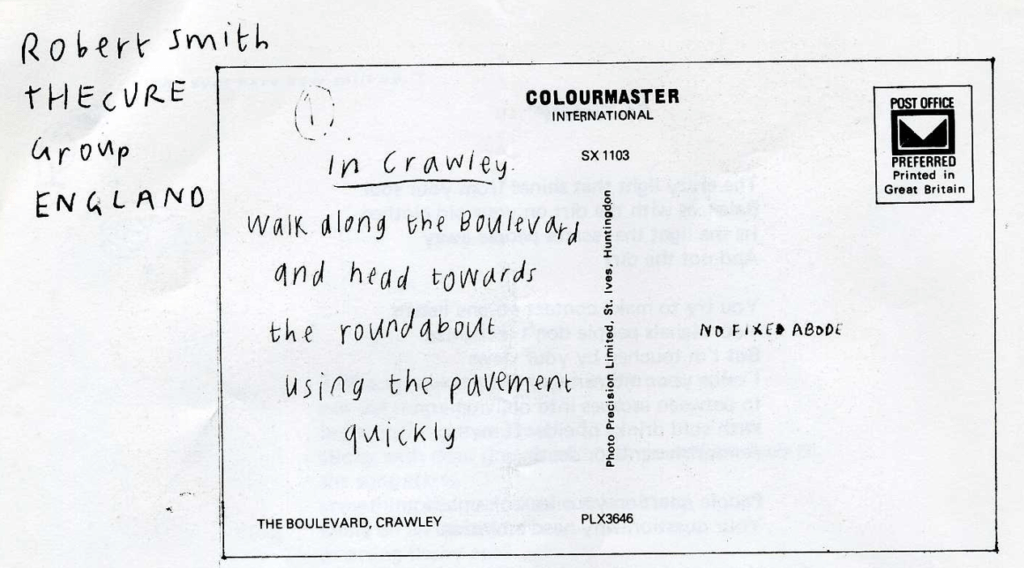
In Part One we journeyed with Lol Tolhurst and Robert Smith as they met on the first day of school, when they were five years old, on the bus to St Francis of Assisi School in Crawley, ‘the first of many journeys together.’ Then, they both went up to Notre Dame Middle School, where they met Michael Dempsey. Tolhurst in his superb book, Cured :The Tale of Two Imaginary Boys remembered them jamming in the school music room in 1972 at Notre Dame school explaining that the Cure really started, “when Robert Michael and I jammed for the first time; the very same line up that recorded Our first single ‘Killing an Arab’, in fact, the cymbal that I use in that song was stolen from the old school kit.”
They called themselves Obelisk and the band played at Upjohn Pharmaceutical’s Christmas party. Robert Smith’s dad, Alex, was the manager at the time. Crawley Museum volunteer, Peter Selby, worked at Upjohn when he was 30 and shared his memories with GIITTV, in Part One saying that he had attended the Christmas Party with the manager’s son Robert playing with his band. He remembers Father Christmas being there and it being ‘very noisy.’ Peter was laughing as he told us that he didn’t realise that he had been to a Cure concert until the exhibition, as he was more of a Beatles fan.
After Notre Dame, Robert, Michael and Lol went to St Winfred’s Secondary school and called themselves Malice. Tolhurst said in his memoir, “Personally, I consider the first gig we did as the band that became The Cure to be the one that we did on December 20, 1976, the Malice gig at our old secondary school, St. Wilfrid’s .” The band were made up of Robert Smith, Michael Dempsey, Lol Tolhurst and Porl/Pearl Thompson. Porl/Pearl brought in singer, Martin Creasy, to do vocals. He had met him at Cloake’s record shop. In Ten Imaginary Years, Robert Smith describes how “He turned up in a three-piece suit, a Manchester United scarf and a motorbike helmet which he refused to part with because he was scared someone would steal it!… He turned out to be a cabaret singer…..Porl felt so humiliated he hit him and Martin fled with the words ‘This is shit!’ No one’s seen him since … We immediately broke up the group!”
Singer, Martin, was kind enough to share his side of the story in Part One stating, “Robert at the end of the shambles… instead of punching me out he simply said, “We’re going to have a meeting at my place next Wednesday… and I went there on Wednesday and he said that he’d just decided to break up and then, of course, he rang everybody he wanted which was everyone bar me. It was a very nice way of doing it and was obviously the right thing to do”.
Straight after Malice disbanded, Easy Cure was formed by Robert Smith along with schoolmates Michael Dempsey, Lol Tolhurst and Porl/Pearl Thompson in 1976. They played throughout 1977, writing and demoing their own songs. They auditioned a number of singers and Peter O’Toole did the vocals from April 1977 until 11th September 1977 before leaving to join a kibbutz. They chose the name Easy Cure by cutting up song lyrics découpé style and putting them in a hat. Easy Cure was a line from one of Lol’s songs,
“Robert had seen something about Bowie or William Burroughs cutting up phrases from their writings into strips and reassembling them into new prose or song lyrics,” said Tolhurst, “So we cut all our own lyrics up and put them into a hat. The first fragment we pulled out would be the name of the band. It seemed both democratic and punky all at the same time.”
Smith recently said in a 6 Music interview that he found the name Easy Cure “A Bit hippish.”

They spent much of their early years practising in St Edward’s Church, Crawley and Robert Smith’s garden in Pound Hill where his dad had built a studio. His house was the open house his dad would brew beer in there. Wendy Paton a Volunteer at Crawley Museum and Smith’s next-door neighbour remembers them rehearsing. She said,
“My family moved into the house next door to Robert Smith in about 1974 when my son, Steven, was 13 and Robert was 15. At that time Robert was already musical and played the piano…Robert’s father had a studio built in his garden so that Robert and his friends could practice their music. They were trying to form a band and his father gave him a year to succeed. The studio was right under our bedroom window so we were frequently woken by their music well into the night. My husband and I didn’t think much of their taste in music but Steve did, so when Robert and Lol went to play for the pupils at Hazelwick and were looking for new musicians, Steve auditioned in guitar and drums but was turned down! “
He did however hear strains of what turned out to be their first hit, ‘Boys Don’t Cry’ coming from the studio. Sometime after that, “Robert stopped playing at home. Another neighbour, Mark, who was a great fan, became a roadie for Easy Cure, as they were then called, for while” and another Crawley resident who was at school with Robert Smith, remembers him tying the bottom of his trousers with string “in case the rats crawled up his legs.”
In a 2008 interview with the Crawley Observer, Lol Tolhurst spoke of their first formal gig saying,“We first played the Rocket pub in Crawley, by the railway station. We used to hang out at The Apple Tree on Sunday lunchtimes too. Occasionally the blues guys would let us play a song or two.” Below is an image of The Rocket (now called the Railway) pub by Crawley station where they played their first gig.
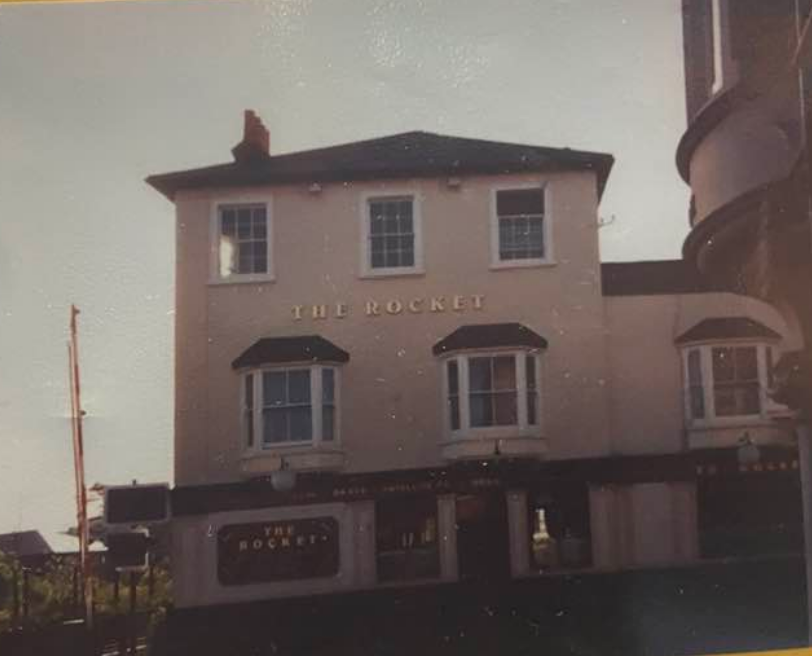
He added: “Looking back on the times it was apparent we were influenced greatly by our surroundings in the same way bands like The Clash were influenced by theirs. We even had a song on our first album, Three Imaginary Boys, that was directly inspired by the railway underpass in Horley called Subway Song. All the eccentric characters we grew up around influenced us greatly too.”

“Remember, although it was the 70s, Crawley and surrounding areas were still undergoing a lot of changes since World War Two and we were part of that too, I feel.”
Perhaps one of the most acclaimed gigs that Easy Cure played was at the Bandstand in Queen’s Square in the centre of Crawley. It is here that we can see some of the earliest footage of Easy Cure. In this video Robert Smith is not yet the lead vocalist – Peter O’Toole is. However, on October 9th 1977, Smith would perform here as the lead vocalist after O’Toole’s departure.
Below is the same bandstand now in 2023, with Lol Tolhurst’s Memoirs Cured:Tale of Two Imaginary Boys. Crawley Museum told us that the bandstand had moved from its original spot in Queen’s Square and is now in the Memorial Gardens in Crawley.

Easy Cure won a talent contest after recording a demo in the dining room at Smith’s parents’ house that saw them sign a recording contract with the German record label, Ariola-Hansa. In September 1977, Peter O’Toole who had been the group’s vocalist for several months left the group to live on a kibbutz. The Record label was trying to market them as a ‘boy band’ which they were not happy with. Cure archivist, John Sanders kindly shared posters from the Easy Cure days with GIITTV:



After O’Toole left, Easy Cure auditioned several vocalists before Robert Smith assumed the role laying the foundations of the Cure that we know and love today. Between October and November 1977, the new four-piece of Smith, Thompson, Dempsey and Tolhurst recorded their first studio demo sessions as Easy Cure for Hansa at SAV Studios in London, but they were unreleased at the time. Crawley residents remember them playing at The Rocket pub, St Edwards and Queen’s Square bandstand throughout 1977 and 1978.
Ariola-Hansa were not happy with Easy Cure’s demos and did not want to release. ‘Killing an Arab’‘ Smith said, “We were very young. They just thought they could turn us into a teen group. They actually wanted us to do cover versions and we always refused” so by 1978 their contract was dissolved.
The band continued to play live. 19th February 1978 was a significant day at the Rocket pub, Crawley, even if they didn’t realise it at the time, as Easy Cure were joined by a support band called Lockjaw, featuring bassist Simon Gallup and keyboardist Matthieu Hartley, who would both later join The Cure. When they played together they called themselves “I know an Easy Cure for Lockjaw.” Archivist, Darren Guy, shared this image of a very rare Lockjaw Demo with GIITTV:

Easy Cure played their last gig at the Montefiore Institute Hall (Three Bridges, where Smith had played football for the Wasps) on 22 April 1978.

Guitarist, Porl/Pearl Thompson was then temporarily dropped from the lineup because his lead-guitar style did not fit with Smith’s preference for more minimalist songwriting at the time. Impact singer, Martin Creasy, described what an excellent guitarist Porl/ Pearl was and how he was ‘”Mad keen on Led Zeppelin,” which is fortuitous because he ended up touring with Page and Plant from Led Zeppelin in 1995 in between joining and re-joining the Cure from 1983–1994 and 2006–2010/11. Pearl was inducted with the rest of the Cure into the Rock n Roll Hall of Fame 2019. Robert’s sister Janet Smith and Porl/ Pearl Thompson later married and one of their four children, Darc Rama, is an artist who is currently releasing outstanding music here: DARC RAMA (bandcamp.com)
Once Porl/Pearl left, they became a trio: Michael Dempsey, Robert Smith and Lol Tolhurst, Robert soon called the remaining trio The Cure. Speaking to 6 Music recently, he said, “I had always thought that Easy Cure was a bit hippyish, a bit American-sounding, a bit West Coast, and I hated it, which put Lol’s back up as he’d thought of it.”

“Every other group we liked that ‘The’ in front of their name but The Easy Cure sounded stupid so we just changed it to The Cure instead. It upset a few old fans… well there you are…I thought The Cure sounded much more like it.”
“The band itself first played in ’76 but we dropped the Easy Cure name and became The Cure. We went down to a three-piece on July 9th. I still have the poster from the Rocket Pub in Crawley, I found it in a box which is quite weird that I would have kept it.” Robert also said that he has a copy of The Cure’s first official show saying, “Yeah I’ve got it on tape, I’m going to release it. It was recorded on an old cassette. I used to record everything from the side of the stage, it’s a bit, scratchy, grungy… it’s noisy.”
“We started the first part of the show with something called Mourning The Departed, which was horribly pretentious. We made this music and we dressed up and we had a séance in the pub before the show and it was all very tongue in cheek but kind of funny. It set the scene for those that didn’t understand what we were doing, which is why we dropped the “Easy” and become The Cure. There were a lot of locals that missed the guitar solos and were outraged that we turned into this horrible post-punk band, but yeah it was good. It ended in a fight as proper gigs usually do, it was a good night.”

Cure archivist John Sanders explained that most of the original The Cure Pictures, including the one above were taken by John Taw. “John and his wife Marg did the first editions of the Cure Fanclub magazines and he took all the photos back then.”
The band recorded their first sessions as a three-piece at Chestnut Studios in Sussex. Parry first heard The Cure when he picked up a bundle of demos that would arrive at the record company every week to listen to over the weekend. “I heard this tape and I really loved it so I called Robert [Smith], he’d written his telephone number on the tape, and he walked into my office and I said to him I really liked your music. He was kind of lanky, but I liked his look.” That started a 20-year relationship with the band.
Chris Parry signed the band to his new label, Fiction records. In December 1978 they released their debut album on Small Wonder until Fiction finalised their distribution arrangements with Polydor. The title of their debut, ‘Killing an Arab’ understandably, caused a lot of controversy. As Smith said, in 2003, “If I knew it before, I would have called it ‘Standing on the Beach’. It would have avoided many troubles.” The song actually referred to French existentialist Albert Camus’ novel ‘The Stranger’ and was met with acclaim by those who knew. Archivist, Darren Guy shared this scan of their first single:

In his acceptance speech for The Cure’s induction into the Rock n Roll Hall of Fame in 2019, Robert Smith spoke of these early gigs and the person who saw a spark in the band. He said, “When we first started, we were a teenage trio in 1978 and at one of our first shows, this small bloke came along, and we weren’t really sure who he was. And he saw something in us that most people didn’t. And that’s Chris Parry. So thanks a lot.”

Builder Bob Peppett remembers Chris Parry and the Cure in those very early days of Fiction records. He worked with renowned Acoustic Architect Michael George to build the Fiction Records headquarters in Charlotte Street, London. In his memories for Crawley Museum, he said that he and Parry were like “two peas in a pod’” while he was building the studio. He remembers seeing The Cure and the Jam in studios. Parry told Peppet, ” It was a good time for music… it was amazing to be involved with all of this stuff.” He believed that it all came to one main thing and that it’s all about the songs. I seem to remember a quote or something he heard, ” Like Colours for the artist, then you can start working the palette…but for a successful musician there needs to be a cogent song.” The Cure, he says, had songs they always had songs. “I knew that I would sign them as soon as I heard them.”
The Cure released their debut album Three Imaginary Boys in May 1979 Smith said, “A lot of it was very superficial – I didn’t even like it at the time. There were criticisms made that it was very lightweight, and I thought they were justified.” Going on tour with Siouxsie and the Banshees had a huge impact on Smith and his musical path, especially when John McKay left the tour and Smith temporarily took his place on guitar. Smith said, “On stage that first night with the Banshees, I was blown away by how powerful I felt playing that kind of music. It was so different to what we were doing with the Cure. Before that, I’d wanted us to be like the Buzzcocks or Elvis Costello; the punk Beatles. Being a Banshee really changed my attitude to what I was doing”, ‘Boys Don’t Cry’ was released on 15 June 1979 as a standalone single and was remixed in 1986 Here is the original:
Crawley continued to be proud of their sons with the Crawley Observer on 18th May stating: “Nationwide Tour…new record due out… The band is on the run for success,” John Sanders shared.

While they were on an upwards trajectory, Robert Smith continued to support local bands, forming a record label, ‘Dance Fools Dance.‘ In 1979 they released a record with side A containing two tracks from The Obtainers and B-Side with two tracks from Mag/Spys (formerly Lockjaw) Simon Gallup and Matthieu Heartley’s band. Archivist Darren Guy said, “Only 100 were pressed – multiple versions with different coloured stickers – (below) is the orange one. I have all but the red one.”

In 1982 Robert Smith’s label ‘Dance Fools Dance’ released a single from Leon Muraglia’s band, Animation. Leon shared his memories with Crawley Museum saying that he had first seen The Cure when he was thirteen at Crawley College and that was a huge fan, having got a backstage pass from Porl Thompson. Leon and his young friends, who later joined The Obtainers band, were trying to get to the front of the crowd from backstage and the promotor told them to jump off stage before the bands started. He said, “We walked on the lights and a huge roar went up. I think it was that moment that I decided to make a career in music.”
Speaking of his band, Animation, Leon said, “Robert Smith lent us his PA for gigs a couple of times and in 1982 we decided to make a 7″ single Our bassist Peter Hardy Suggested that Robert (Smith) Produce it. It came out on his Dance Fools Dance Label. We Pressed 500 singles which Smith left in the back of his car for a few sunny days when he went on a drinking binge with Siouxsie and the Banshees so half of them were badly warped. In the book ‘Ten Imaginary Years’ Smith describes it as ‘terrible’ and he’s quite right. ‘ said Leon ‘Animation split soon after. He went on to explain how Smith was “A neighbour in Pound Hill so I’d often pop round a talk for a while. He was always affable and encouraging of his music.”

In November 1979, whilst The Cure were still going strong, they had a parallel side project; called Cult Hero, explained Darren Guy. The songs were written for and featured Postman, Frank Bell, on vocals accompanied by Robert Smith of The Cure, Simon Gallup, Matthieu Hartley, Pearl Thompson, The Obtainers and Robert’s sisters, Janet and Margret: It was produced by Chris Parry.

Cult Hero was created by Robert Smith as a way to test his musical compatibility with Simon Gallup, then bassist of Mag/Spys who had played with Easy Cure at The Rocket. Keyboardist Matthieu Hartley from Mag/Spys joined the Cure in November 1979. At the time Smith was considering Gallup as a prospective replacement for Michael Dempsey, the Cure’s bassist at the time. Cult Hero also features Malice/Easy Cure guitarist Porl/Pearl Thompson and an extensive line-up of friends and family, including local band, The Obtainers and Robert’s sisters. You can hear them all performing here:
In 1980 Cult Hero Performed at the Marquee in London. Darren Guy shared a rare poster of the gig with GIITTV.

Several members of Cult Hero ended up joining the Cure including. Bassist Simon Gallup, keyboardist Matthieu Hartley and guitarist Porl / Pearl Thompson. The Cure’s originalThree Imaginary Boys album was reissued on 29 November 2004 (featuring Smith, Tolhurst and Dempsey) and the reissue featured a second bonus disc of unreleased material, including songs recorded under the band name Easy Cure with Porl/ Pearl Thompson on guitar, like a full circle.
The Cure have continued to trailblaze and thrill audiences across the world for decades, but they have never forgotten their roots. They are world-class yet “down to earth” stars who have picked up major awards over the years including two Brit Awards, an MTV Award, NME’s Godlike Genius and Festival Headliner Award. In 2022, Robert Smith and Simon Gallup picked up an Ivor Novello Icon Award, while The Cure, in all its incarnations, were inducted into the Rock and Roll Hall of Fame in 2019. From Crawley to the Stars, “Everything you do is irresistible.” The First Punks in Crawley are now icons across the Globe From South Park to Steyning, Poynings to Peru, excitement is building as fans eagerly await news of their upcoming album, Songs Of A Lost World, which there were tantalizing glimpses of during their 2022 European tour. We can’t wait to hear what The Cure have in store for 2023.
Can you help Crawley Museum Create a permanent Cure Collection? Current Museum curator, Holly Parsons, said, “We would love to have a permanent Cure collection because so many people ask for it ” Please get in touch if anyone has anything that they wish to donate relating to The Cure in Crawley [email protected].
Cure Archivist, Darren Guy is also looking for rare records and rare Cure items from throughout their career: Contact: [email protected]
With huge thanks to Cure Archivists: Darren Guy and John Sanders for their expertise and additional archives, Andrea Dumbrell 2018 Curator of Crawley Museum for letting us revisit the 2018 archives, Holly Parsons Current Curator of Crawley Museum, all at Crawley Museum, Peter Selby, Wendy Patton, Renny Richardson, John Taw’s photos, Leon Muraglia, Martin Creasy.
Thank you to all at Crawley Museum, Ref: Cured: The Tale of Two Imaginary Boys (2016) by Lol Tolhurst. Cured – Lol Tolhurst and Ten Imaginary Years – Southerland, Smith and Barbarian (1988) Sussex World and Crawley Observer.
See The Formation of the Cure (Part One) here

